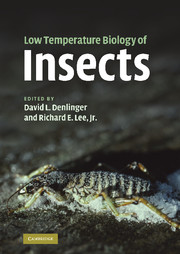Book contents
- Frontmatter
- Contents
- List of contributors
- Preface
- PART I PHYSIOLOGICAL AND MOLECULAR RESPONSES
- PART II ECOLOGICAL AND EVOLUTIONARY RESPONSES
- 8 The macrophysiology of insect cold-hardiness
- 9 Evolutionary physiology of insect thermal adaptation to cold environments
- 10 Insects at not so low temperature: Climate change in the temperate zone and its biotic consequences
- 11 Genetic variability and evolution of cold-tolerance
- 12 Life-history adaptations to polar and alpine environments
- PART III PRACTICAL APPLICATIONS
- Index
- References
12 - Life-history adaptations to polar and alpine environments
from PART II - ECOLOGICAL AND EVOLUTIONARY RESPONSES
Published online by Cambridge University Press: 04 May 2010
- Frontmatter
- Contents
- List of contributors
- Preface
- PART I PHYSIOLOGICAL AND MOLECULAR RESPONSES
- PART II ECOLOGICAL AND EVOLUTIONARY RESPONSES
- 8 The macrophysiology of insect cold-hardiness
- 9 Evolutionary physiology of insect thermal adaptation to cold environments
- 10 Insects at not so low temperature: Climate change in the temperate zone and its biotic consequences
- 11 Genetic variability and evolution of cold-tolerance
- 12 Life-history adaptations to polar and alpine environments
- PART III PRACTICAL APPLICATIONS
- Index
- References
Summary
Introduction: extremes in the terrestrial environment
This chapter is concerned with the life-history features of terrestrial invertebrates inhabiting the cold regions of the world. It predominantly focuses on the Antarctic continent and the Arctic elements of the large northern continents, also drawing parallels with the alpine regions of the world's major mountain ranges. To human perception, these polar and montane regions of the planet are clearly challenging regions in which to live. They face environmental stresses that operate on a range of timescales, for example from chronic exposure to low temperature, high winds, freezing, or desiccation, to extreme or short-term acute events. At northern or southern latitudes beyond the polar circles, the sun remains permanently below the horizon for a period of days to months, depending on latitude, each winter, inevitably imposing considerable seasonality on organisms and ecosystems.
Focusing simply on temperature, in the absence of solar-energy input, terrestrial habitats of both regions face comparable extremely low air temperatures during winter. But the two regions are far from identical, with the Antarctic also enduring much lower typical summer temperatures than those of the Arctic (Convey, 1996a; Danks, 1999); hence lack of available energy provides a major constraint on biological activity here. However, the biological impacts of temperature are not well described simply by standard meteorological measures of mean air temperature, and scales and patterns of physical and temporal variation are also important.
- Type
- Chapter
- Information
- Low Temperature Biology of Insects , pp. 297 - 322Publisher: Cambridge University PressPrint publication year: 2010
References
- 10
- Cited by



